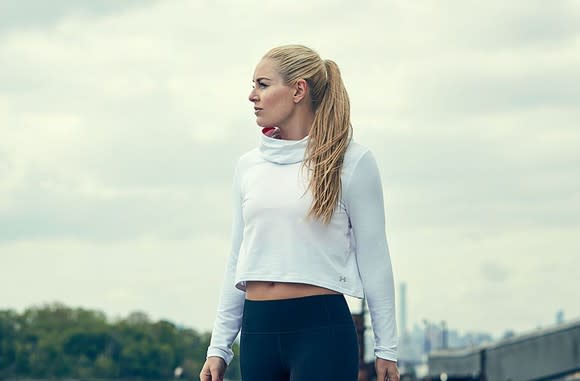The Biggest Disappointment in Under Armour's Results
Sportswear apparel company Under Armour (NYSE: UA) (NYSE: UAA) has been struggling with the difficult retail environment in the U.S., but it seems like things have gone from bad to worse. The company reported that one of its key growth pillars, women's apparel, saw a decline in the most recent quarter. The company has fought hard to build this $1 billion business and this miss has to be the company's biggest disappointment in its earnings release.
"Disappointment"
CEO Kevin Plank opened the earnings call with analysts saying that he'd "like to take a moment to acknowledge the disappointment that we feel about our financial performance in 2017." David Bergman, chief financial officer, went on to detail what products types contributed to the disappointing 5% top-line decline.
"Apparel revenue decreased 8% to $940 million as growth in golf and sports style product was more than offset by declines in our outdoor, women's training and youth categories," he said.
While the company expected challenges in North America, it probably didn't expect this result from its women's training category. In an interview with Goldman Sachs in September, Bergman had said women's apparel was one of the "levers" the company could use to offset the weakness in domestic retail. The category's decline in the recent quarter is especially disappointing after the company just finished a significant marketing campaign called "Unlike Any" that featured its women athletes, and its promising partnership with Kohl's, whose customers are predominantly women.

Lindsey Vonn pictured for the Unlike Any advertising campaign. Image source: Under Armour.
While the women's business was a drag this quarter, building the women's product line has been an integral part of Under Armour's growth story, and a source of pride.
Building the category
The company started its women's business in 2000 and ended up scrapping the entire first run of its original clothing line because of poor quality. The company became more serious about its women's brand when it signed Olympic skier Lindsey Vonn in 2006. In 2014, the company signed Misty Copeland, the first African-American female principal dancer with the American Ballet Theater. Copeland was the center of the company's "I Will What I Want" campaign that was named AdAge's campaign of the year.
By 2016, the women's brand for Under Armour had reached the $1 billion mark. Plank had this to say about it in the October 2016 quarterly conference call:
...when you talk about our women's business, we have [a] $1 billion women's brand. It's taken us one heck of a long time to get here, but we're incredibly proud of what that means.
In that same earnings call, Plank said that the women's category "remains one of our brightest opportunities for growth in our business." You have to go back to the company's investor day in 2015 to understand why Plank has characterized its women's business that way.
Incredible potential
For the 2015 investor day, Kelly Cortina, then vice president in charge of the women's category, opened up the discussion on the opportunity for the category with a bold statement.
We have a very big vision around this business. Women's will be a major global growth driver for the Under Armour brand, and we look forward to the day that we are as big or bigger than our men's business.
While that seemed to be an audacious claim, Cortina followed up with some data about female participation in sports and fitness that gave investors an idea that it was possible. She went on to say that 42% of all high school athletes are female and that "soccer participation for females has tripled in the last 15 years." Motley Fool analyst Sarah Priestley expanded on these numbers in this "girl power" podcast. Priestley indicated that 90% of the growth in high school sports from 1970 to 2016 was due to women, and that women make up 57% of competitors in running races in the U.S.
At the time of the investor day presentation, the women's business was growing 40% annually, had 100 million women as users on the company's fitness apps, and had seemingly unlimited potential. When this quarter showed a decline for the women's segment, I imagine the word "disappointed" is understating how Plank feels about the result.
Just before the company's earnings release, it was reported that two senior executives would be leaving the company: the chief marketing officer and the head of the women's and youth categories. On the earnings call Plank indicated that "footwear and women's is a place where we feel like we can be and do a much better job."
While admitting a problem is the first step to fixing it, there will be much more that's needed to improve results with this important product category.
More From The Motley Fool
6 Years Later, 6 Charts That Show How Far Apple, Inc. Has Come Since Steve Jobs' Passing
Why You're Smart to Buy Shopify Inc. (US) -- Despite Citron's Report
Brian Withers owns shares of Under Armour (A Shares) and Under Armour (C Shares). The Motley Fool owns shares of and recommends Under Armour (A Shares) and Under Armour (C Shares). The Motley Fool has a disclosure policy.
